Woodworking Power Tools
When planning a carpentry project, it is important to have the proper tools for the job – tools that will be able to drill, cut, or sand as needed (like with a benchtop drum sander) to fulfill the needs of the project. And you might be surprised at how very many such tools there are, all with their own unique role to play. Even tools like electric demolition hammers get used in some wood building projects.
Detailed below is an informational guide on the most common woodworking power tools.
By increasing your knowledge of what each tool can lend in productivity on your own woodworking projects, you can determine which tools may be necessary or unnecessary for your use.
Table Saw
Common uses for a table saw:
- Cut flat surfaces
- Crosscut materials such as panels and boards
- Saw grooves and mitered joints
- Cut deep into harder woods
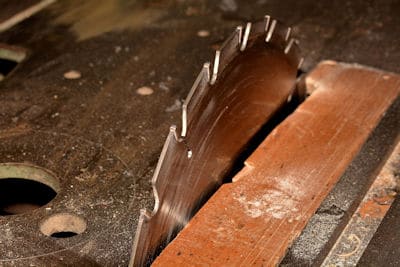 The table saw is often the first major purchasing decision woodworkers make for their workshop. Table saws are available in two different models: a floor-top or a benchtop model. They are also available in two different styles: a cabinet maker’s style or contractor’s style.
The table saw is often the first major purchasing decision woodworkers make for their workshop. Table saws are available in two different models: a floor-top or a benchtop model. They are also available in two different styles: a cabinet maker’s style or contractor’s style.
The features of a table saw may vary somewhat from brand to brand. Generally, however, the two styles of table saws feature the same blade adjustments. The differences primarily pertain to cost, voltage requirements, and other aspects of operation.
Cabinet maker’s style table saws, for instance, typically offer less vibration than a contractor’s style saw, and operate with more power. Cabinet maker’s style saws also tend to run at higher prices, so this may be a consideration for those buying tools on a budget. Remember, saws can put significant amounts of sawdust into the air in your shop, so be sure to look at shop dust collectors before you do much cutting.
Chop Saw (Miter Saw)
Common uses for a chop saw:
- Cut from a variety of angles
- Quick, accurate crosscuts
- Cut crown molding and trim
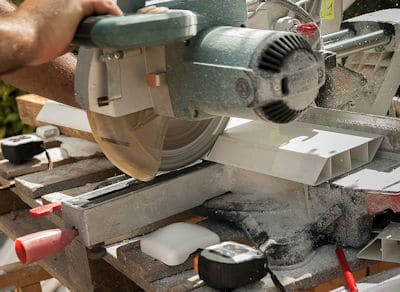 Sometimes referred to as a miter saw, a chop saw is a medium-sized woodworking power tool that features a circular blade able to cut materials from top to bottom quickly and precisely. Some argue that chop saws should be differentiated from miter saws, as the former are often somewhat larger – with a minimum 14-inch blade compared to the latter’s usual 8-12 inches. Miter saws are also capable of rotating and making angled cuts, while chop saws may be limited cutting straight, 90-degree angles. For more info read our review of the best budget mitre saws.
Sometimes referred to as a miter saw, a chop saw is a medium-sized woodworking power tool that features a circular blade able to cut materials from top to bottom quickly and precisely. Some argue that chop saws should be differentiated from miter saws, as the former are often somewhat larger – with a minimum 14-inch blade compared to the latter’s usual 8-12 inches. Miter saws are also capable of rotating and making angled cuts, while chop saws may be limited cutting straight, 90-degree angles. For more info read our review of the best budget mitre saws.
Circular Saw
Common uses for a circular saw:
- Producing cutouts in larger wooden materials
- Cutting sheet goods
- Cutting lumber to size for construction projects
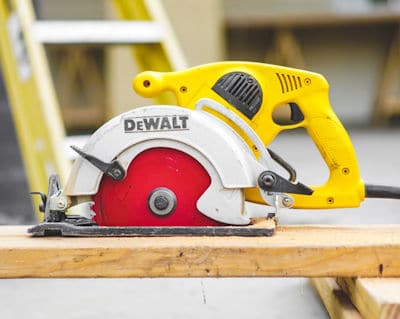 Circular saws are another basic handheld woodworking power tool often utilized by both beginners and experts. Considered a versatile tool, and convenient due to its portability, circular saws may be one of the tools to purchase for woodworking beginners on a budget.
Circular saws are another basic handheld woodworking power tool often utilized by both beginners and experts. Considered a versatile tool, and convenient due to its portability, circular saws may be one of the tools to purchase for woodworking beginners on a budget.
Circular saws are available in two different styles: those featuring a worm-drive mechanism, and those with a helical-gear mechanism for driving the saw’s blade.
Circular saws are also available as either battery or AC-powered; the former is known for producing less horsepower, however, and may therefore not be efficient for cutting larger materials.
Jig Saw
Common uses for a jig saw:
- Cutting angles up to 45 degrees
- Making straight, circular, or curved cuts
- Cutting through a variety of materials
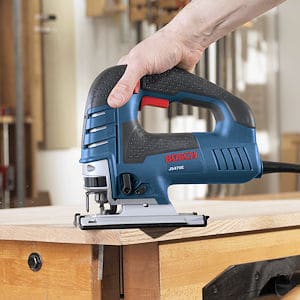 Jig saws are another common woodworking tool suitable for beginners. Generally easy to use, jig saws are particularly handy for cutting through thinner materials, including particleboard and plywood.
Jig saws are another common woodworking tool suitable for beginners. Generally easy to use, jig saws are particularly handy for cutting through thinner materials, including particleboard and plywood.
When working with wood, they are typically capable of cutting up to 2 inches in depth and should not be used for deeper cuts as this can cause the blades to bend or even break.
Lathe
Common uses for a lathe:
- Cutting symmetrical shapes around an axis of rotation – suitable for making bowls, table legs, spindles and other round parts
 A lathe may be used for woodworking projects that involve shaping round parts, such as table legs or spindles, with its rotary power. The rotary power of the tool enables users to make symmetrical cuts around an axis of rotation, while the tool also keeps the material held steady. Objects such as bowls, for instance, may be shaped by mounting the wooden material on the headstock of the lathe. Check out our wood lathe comparison chart for help choosing the right lathe for your shop.
A lathe may be used for woodworking projects that involve shaping round parts, such as table legs or spindles, with its rotary power. The rotary power of the tool enables users to make symmetrical cuts around an axis of rotation, while the tool also keeps the material held steady. Objects such as bowls, for instance, may be shaped by mounting the wooden material on the headstock of the lathe. Check out our wood lathe comparison chart for help choosing the right lathe for your shop.
Drill Press
Common uses for a drill press:
- Drilling small holes
- Boring large holes
- Producing repetitive, consistent holes
- Drilling angled holes
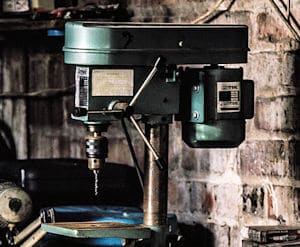 Also known as a pedestal drill, a drill press is a useful woodworking power tool for projects that involve drilling small or large holes into wooden pieces or sanding curved surfaces.
Also known as a pedestal drill, a drill press is a useful woodworking power tool for projects that involve drilling small or large holes into wooden pieces or sanding curved surfaces.
By setting the desired depth, users can drill accurate holes that may be applicable for a number of woodworking projects such as crafting furniture. A drill press may be installed with other pieces or tools such as radial arm saw or different drilling bits for differently-shaped or sized holes. Read our review of the top woodworking drill presses for more information.
Cordless Drill
Common uses for a cordless drill:
- Drilling holes in hardwood
- Driving screws
- Sanding contours and curved surfaces
Although cordless drills often appear larger than their corded counterparts due to battery packs, cordless power drills are considered more portable, and therefore more convenient, than a corded power drill. Corded drills are commonly used for drilling holes of all sizes and driving screws and bolts into wooden pieces. When paired with a stud finder (see our stud finder review here) they become a formidable picture hanging tool.
There are specialty items within this category – see our review of the best cordless right-angle drills for one example. These are great tools to use on a variety of projects, like installing sliding barn doors.
Reciprocating Saw
Common uses for a reciprocating saw:
- Sawing for demolition projects
- Sawing through materials for remodeling purposes
The most noteworthy feature of the reciprocating saw is its push-and-pull cutting motion when utilized safely by a woodworker. Its ability to cut through many tough materials – including lumber – makes it a particularly useful tool for demolition or remodeling projects.
As a handheld device that allows variable speed control and is suitable for heavy-duty applications, a reciprocating saw is ideal for cutting through wooden pieces or lumber that are outdoors.
Benchtop Planer
Common uses for a benchtop planer:
- Smoothing rough lumber
- Reclaiming old wood
- Cutting wood into desired thickness
Benchtop planers are commonly used for smoothing old or rough wooden surfaces. These tools can also be cost-effective, as they allow woodworkers to buy less-expensive, rougher wood for projects that can then be smoothed with the planer. The tool features a universal motor and may require patience as it works most efficiently when removing 1/16 of an inch of material or less at a time. We review the best thickness planer for the money to help you get a good deal. If you want to kill 2 birds with one stone, check out our review of the best jointer planer combos.
Orbital Sander
Common uses for an orbital sander:
- Stock removal
- Ultra-smooth sanding in an orbital motion
Orbital sanders are a common, versatile handheld tool often wielded by woodworkers for smooth sanding purposes. There are both random orbital sanders and orbital finishing sanders – the two tools differentiated by the former featuring a round pad, and the latter a square one. The round pad of a random orbit sander allows the sander to move in “random orbits”, and although it may remove wood a bit slower than a standard orbit sander, it nevertheless serves as a portable, versatile tool for any woodworker working on a project that requires sanding.
If you have a project that requires a belt sander, check out our review of sanders for decks or our review of belt grinders.
So, now that you know a bit about each of these goodies, which one do you need to add to your shop to get your next project underway?